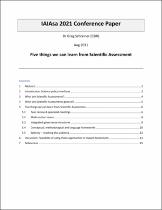JavaScript is disabled for your browser. Some features of this site may not work without it.
- ResearchSpace
- →
- Research Publications/Outputs
- →
- Conference Publications
- →
- View Item
| dc.contributor.author |
Schreiner, Gregory O

|
|
| dc.date.accessioned | 2022-03-13T16:46:34Z | |
| dc.date.available | 2022-03-13T16:46:34Z | |
| dc.date.issued | 2021-08 | |
| dc.identifier.citation | Schreiner, G.O. 2021. Five things we can learn from Scientific Assessment. http://hdl.handle.net/10204/12315 . | en_ZA |
| dc.identifier.uri | http://hdl.handle.net/10204/12315 | |
| dc.description.abstract | The disciplinary domains known as ‘Impact Assessment’ and ‘Scientific Assessment’ occupy fairly similar spaces at the contemporary Science-Policy Interface. At their essences, both concern themselves with providing the evidence-base to support decision-making with a view toward ‘sustainable development’. Where Impact Assessment emerged primarily from the practitioner community in response to early environmental regulation in the 1970sin some developed countries, Scientific Assessment emerged about a decade later, to tackle meteorological issues of global importance, like ozone depletion and climate change. These two communities of practice share a few similarities. Primarily that they both wrestle with the complex challenges inherent to the 21st Century socio-ecological landscape. In this sense it is rather unfortunate that these communities seldom speak to one another. Following deep study of Scientific Assessments as part of my PhD research from 2017-2020, the purpose of this paper, drafted for IAIAsa 2021, is to explore which areas of Scientific Assessment are highly effective and then propose how these areas might be incorporated more into Impact Assessment practice, if possible and feasible. The five areas of practice I propose are: 1) peer review and specialist meetings, 2) multi-author teams, 3) integrated governance structures, 4) robust conceptual, methodological, and linguistic frameworks and 5) saliency through novel content communication techniques. | en_US |
| dc.format | Fulltext | en_US |
| dc.language.iso | en | en_US |
| dc.source | Re-thinking IEM in pursuit of the Sustainable Development Goals (IAIAsa), 17- 9 August 2021 (Virtual) | en_US |
| dc.subject | Impact Assessment | en_US |
| dc.subject | Integrated governmence structure | en_US |
| dc.subject | Scientific Assessment | en_US |
| dc.title | Five things we can learn from Scientific Assessment | en_US |
| dc.type | Conference Presentation | en_US |
| dc.description.pages | 16 | en_US |
| dc.description.note | Presented at the Re-thinking IEM in pursuit of the Sustainable Development Goals (IAIAsa), 17-19 August 2021 (Virtual) | en_US |
| dc.description.cluster | Smart Places | en_US |
| dc.description.impactarea | EMS | en_US |
| dc.identifier.apacitation | Schreiner, G. O. (2021). Five things we can learn from Scientific Assessment. http://hdl.handle.net/10204/12315 | en_ZA |
| dc.identifier.chicagocitation | Schreiner, Gregory O. "Five things we can learn from Scientific Assessment." <i>Re-thinking IEM in pursuit of the Sustainable Development Goals (IAIAsa), 17- 9 August 2021 (Virtual)</i> (2021): http://hdl.handle.net/10204/12315 | en_ZA |
| dc.identifier.vancouvercitation | Schreiner GO, Five things we can learn from Scientific Assessment; 2021. http://hdl.handle.net/10204/12315 . | en_ZA |
| dc.identifier.ris | TY - Conference Presentation AU - Schreiner, Gregory O AB - The disciplinary domains known as ‘Impact Assessment’ and ‘Scientific Assessment’ occupy fairly similar spaces at the contemporary Science-Policy Interface. At their essences, both concern themselves with providing the evidence-base to support decision-making with a view toward ‘sustainable development’. Where Impact Assessment emerged primarily from the practitioner community in response to early environmental regulation in the 1970sin some developed countries, Scientific Assessment emerged about a decade later, to tackle meteorological issues of global importance, like ozone depletion and climate change. These two communities of practice share a few similarities. Primarily that they both wrestle with the complex challenges inherent to the 21st Century socio-ecological landscape. In this sense it is rather unfortunate that these communities seldom speak to one another. Following deep study of Scientific Assessments as part of my PhD research from 2017-2020, the purpose of this paper, drafted for IAIAsa 2021, is to explore which areas of Scientific Assessment are highly effective and then propose how these areas might be incorporated more into Impact Assessment practice, if possible and feasible. The five areas of practice I propose are: 1) peer review and specialist meetings, 2) multi-author teams, 3) integrated governance structures, 4) robust conceptual, methodological, and linguistic frameworks and 5) saliency through novel content communication techniques. DA - 2021-08 DB - ResearchSpace DP - CSIR J1 - Re-thinking IEM in pursuit of the Sustainable Development Goals (IAIAsa), 17- 9 August 2021 (Virtual) KW - Impact Assessment KW - Integrated governmence structure KW - Scientific Assessment LK - https://researchspace.csir.co.za PY - 2021 T1 - Five things we can learn from Scientific Assessment TI - Five things we can learn from Scientific Assessment UR - http://hdl.handle.net/10204/12315 ER - | en_ZA |
| dc.identifier.worklist | 25192 | en_US |






